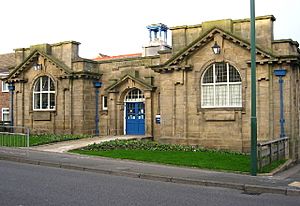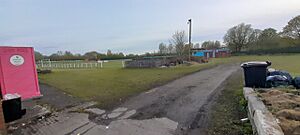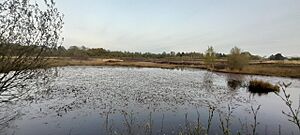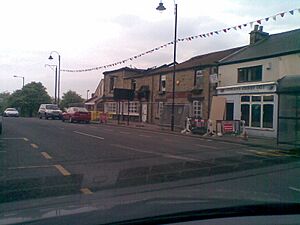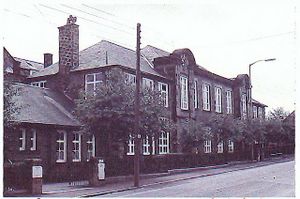Annfield Plain facts for kids
Quick facts for kids Annfield Plain |
|
|---|---|
| Village | |
| Population | 7,774 (2011.ward) |
| OS grid reference | NZ169514 |
| Unitary authority | |
| Ceremonial county | |
| Region | |
| Country | England |
| Sovereign state | United Kingdom |
| Post town | STANLEY |
| Postcode district | DH9 |
| Dialling code | 01207 |
| Police | Durham |
| Fire | County Durham and Darlington |
| Ambulance | North East |
| EU Parliament | North East England |
| UK Parliament |
|
Annfield Plain is a village in County Durham, England. It sits on a high area of land between the towns of Stanley, about 3 miles (5 km) to the north-east, and Consett, about 5 miles (8 km) to the west.
In 2011, Annfield Plain was part of Stanley parish and had a population of 7,774 people. Like many places nearby, Annfield Plain's past is strongly linked to coal mining.
The land around the village is mostly wild moorland. You can see the tall Pontop Pike television mast from here. Even though it's near the countryside, Annfield Plain is also close to bigger cities. Newcastle is about 12 miles (19 km) away, and Sunderland is a similar distance. The old cathedral city of Durham is about 10 miles (16 km) away. It offers a big difference from the former mining villages like Annfield Plain.
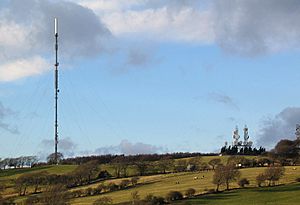
Contents
What's in a Name?
The name "Annfield" first appeared as "Anfield." It likely came from "the fields of An," referring to a person who lived there before the Norman Conquest.
The "Plain" part of the name was originally "Plane." This didn't mean a flat area of land at first. Instead, it referred to an inclined plane on the Stanhope and Tyne Railway built in 1834. An inclined plane is like a sloped track where wagons are pulled up or down. The engine used on this plane was called the Anfield Engine. This was because it was near Anfield House, a building from the 1700s on Loud Hill. The spelling changed to "Annfield Plain" around 1856. This was when houses were built for miners on the flat land nearby.
A Look Back in Time
The first signs of people living in this area date back to the 1500s. Back then, the main activity was sheep farming. The village's connection to mining started in the late 1600s. Many shallow mines were dug to get coal.
The Stanhope and Tyne Railway, built in 1834, made it easier to transport coal. Several limekilns were also built around this time. These kilns used local coal to burn limestone, which was brought in by train.
During the Industrial Revolution, the need for coal grew a lot. Many deep mines were dug in the 1800s. The village grew quickly, and small industries appeared. These included a brewery, a mill, and a candle factory. Services for the growing population also increased. There was a school, a church, at least two chapels, and many shops.
Annfield Plain Golf Club opened in 1907 but closed in 1931.
Annfield Plain Today
Annfield Plain is located where two main roads used to meet. These were the old A693 (between Consett and Stanley) and the B6168 (heading north towards Catchgate). Now, the A693 goes around the village. Another road, the A6076, goes south-west towards Maiden Law.
Most of Annfield Plain is made up of homes and village shops. There is some light industry, mainly at the nearby Greencroft Industrial Park. The village has a working men's club and two pubs: the Coach and Horses, and the Queen's Head. Other pubs, like the Smugglers Arms and the Plainsman, have closed.
The local Tesco supermarket used to be a Co-op. People often called it the "Disco." This was because its old name was the "Annfield Plain Co-op and Discount Electricals." The original Annfield Plain co-operative store was taken apart. It was then rebuilt at the Beamish Open Air Museum in the late 1980s. The site of the village's main coal mine, called the Busty, is now a private garage for coaches.
The Annfield Plain Public Library is located just over the border in Catchgate.
The C2C cycle path goes right through Annfield Plain. This route stretches from Whitehaven on the west coast to Sunderland on the east coast. It follows the path of the old Stanhope and Tyne Railway. The C2C enters Annfield Plain from the east and leaves towards Greencroft Industrial Estate. It passes Annfield Plain Park before heading west.
Annfield Plain F.C., the local football club, plays at Derwent Park Stadium. This stadium is on the south-west side of Annfield Plain, next to Greencroft Nature Reserve and Alexander Pond. Annfield Plain Cricket Club is also in the western part of the village within Greencroft.
Annfield Plain Park is on the south side of the village. It has tennis courts, a bowling green, a children's play area, and a basketball court. There is also a war memorial and a large green area with football pitches.
Where is Annfield Plain?
Local Government
Annfield Plain is part of the County Durham area. Two local councillors, Michele Hodgson and Thomas Nearney (both from the Labour party), represent it on the Durham County Council. The village is also part of the North Durham area for the UK Parliament. As of 2005, Kevan Jones (Labour) is the Member of Parliament for this area.
The local police force is Durham Constabulary. Annfield Plain is in the Derwentside area, and its closest police station is in Catchgate.
Location Details
- Height: Annfield Plain is about 250 meters (850 feet) above sea level.
- Road Access: You can reach it by the A693 between Stanley and Consett, and many smaller roads.
- Train Access: The nearest train station is in Chester-le-Street, about 11 kilometers (7 miles) away by road.
Villages Nearby
Several other villages are very close to Annfield Plain, almost joining it:
- Greencroft to the west
- New Kyo to the east
- West Kyo and Catchgate to the north
Famous People from Annfield Plain
- Alun Armstrong - a well-known actor who was in the original cast of Les Misérables. He also appeared in New Tricks and The Mummy Returns.
- Tom Lamb - a former miner who became an artist. He drew pictures showing what life was like for miners underground.
- Joseph Crawford - he was the President of the Trades Union Congress and a leader for miners' safety.
- Glenn McCrory - a former world champion boxer in the Cruiserweight division.
- Micky Horswill - a former professional footballer.



